Navigating the Evolving Cybersecurity Landscape with Platforms like authentik

The threats and challenges are constantly evolving in the ever-changing realm of cybersecurity. As malevolent actors devise new methods to breach systems, the onus is on platforms like authentik to stay ahead of the curve and ensure their authentication mechanisms are robust and adaptable. Here’s a glimpse into how such platforms might adapt in the face of emerging cybersecurity threats:
1. Multi-Factor Authentication (MFA):
- Enhanced MFA: While MFA is already a standard, future iteration might involve more sophisticated methods, such as behavioral biometrics, where user behavior (like typing speed or device handling patterns) becomes an authentication factor.
- Adaptive MFA: Systems could assess the risk level of a login attempt based on various factors (e.g., location, device, time of access) and require additional authentication steps for suspicious attempts.
2. Biometric Evolution:
- Continuous Authentication: Instead of a one-time login, systems might continuously monitor biometric data, such as facial recognition or voice patterns, throughout a user’s session to ensure the user’s identity.
- Anti-Spoofing Measures: As biometric hacking becomes more sophisticated, platforms must implement measures to detect and prevent spoofing attempts, like 3D facial recognition, to counteract photo-based hacks.
3. Decentralized Authentication:
- Blockchain-Based Systems: Leveraging blockchain’s immutable and decentralized nature, platforms might move towards decentralized identity verification systems, reducing the risks associated with centralized data breaches.
4. AI and Machine Learning:
- Predictive Analysis: AI could analyze login patterns and behaviors to predict and flag potential threats before they materialize.
- Real-time Threat Response: Machine learning algorithms could adapt in real-time to emerging threats, updating authentication protocols on the fly.
5. Passwordless Authentication:
- Token-Based Systems: Users might receive time-sensitive tokens on their devices to gain access instead of passwords.
- Physical Security Keys: Hardware-based security keys might become more prevalent, offering a physical two-factor authentication method.
6. Enhanced Encryption:
- Quantum-Resistant Encryption: As quantum computing advances, there’s potential for it to break traditional encryption methods. Platforms will need to adopt quantum-resistant encryption algorithms to stay secure.
7. User-Centric Approaches:
- User Education: Platforms might invest more in educating users about security best practices, recognizing that human error is often a significant vulnerability.
- Personalized Security: Users can customize their security protocols based on their preferences and risk tolerance.
The future of authentication in the face of evolving cybersecurity threats is a dynamic landscape. Platforms like authentik will need to be proactive, innovative, and user-centric. By leveraging emerging technologies and staying attuned to the latest threats, they can ensure that their authentication mechanisms remain robust and flexible, safeguarding users and data in an increasingly interconnected digital world.